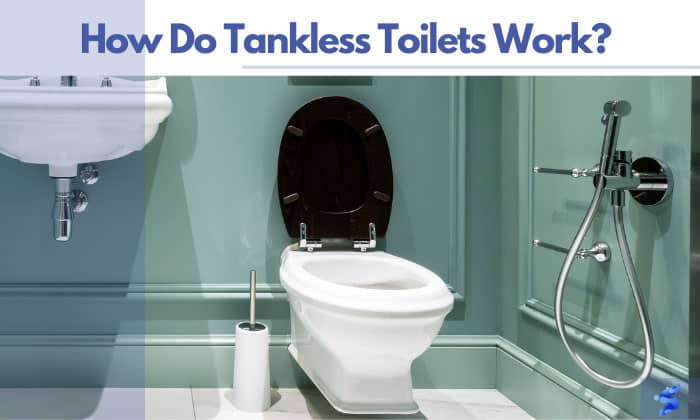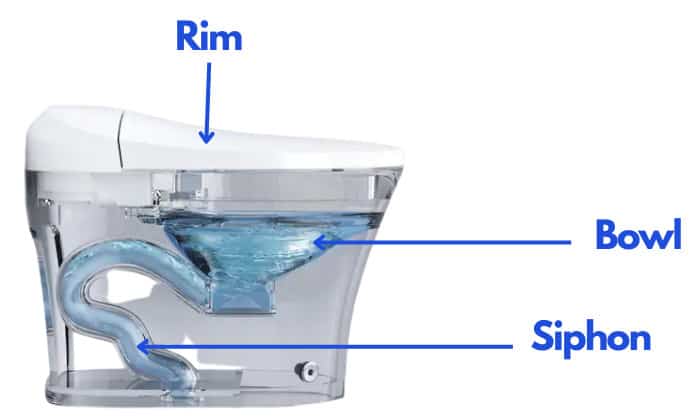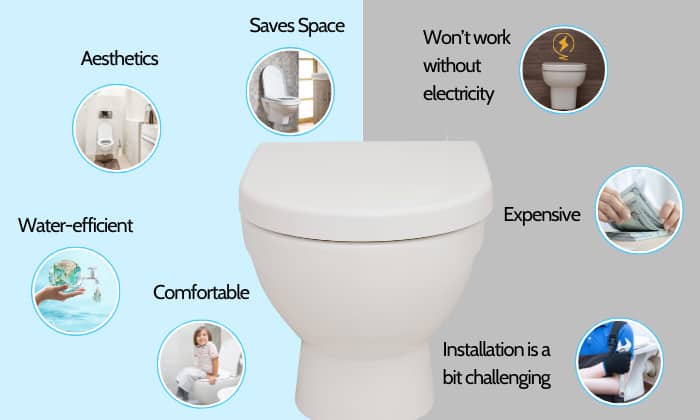If you’ve seen a tankless toilet, you might wonder how it flushes down the waste without the sight of a tank. I’m curious because I like to upgrade my bathroom with this new type of fixture to save space. Before we make that purchase decision, let’s clarify, how do tankless toilets work?
A tankless toilet relies on the supply line’s high water pressure to push the waste down the drain. It uses an electric pump to boost the flushing power. The water doesn’t overflow because the toilet is built with a valve.
Let’s discuss more on tankless toilets below.
Table of Contents
What is a Tankless Toilet?
Unlike a traditional toilet with large tanks at the back, tankless models are toilets without tanks.
These units connect directly to the water supply line to deliver water for flushing. Thanks to the electric pump inside the bowl, the pressure is boosted to push the waste into the sewer pipe and clean the bowl in a single flush.
The toilet seats may vary in length, from 16 inches to 18 inches. The height is pretty extensive, at least 17 inches, to make the unit more comfortable to use.
One of the best brands of tankless toilets is Kohler. Their Avoir tankless toilet has an elongated bowl that looks sleek and feels comfortable to use. The flush button of this floor mounted tankless toilet is placed at the side, making it easy to reach when sitting.
How Does It Work?
A tankless toilet works with the high pressure of your water to push the waste down the waste line. Instead of using the water behind the tank, the water comes directly from the supply line. The electrical pump moves the water from the supply line to the toilet.
Most commercial tankless toilet units use a valve to control how much water to use for flushing. If you notice, these units leave a little amount of liquid after flushing with great force. Today, you can even find a hands-free mechanism of flushing to make the toilet experience more sanitary.
Only a few residential tankless toilet models use a flush valve technology because the water pressure is lower at home. Crowdy urban apartments use this technology to save space or improve the aesthetics of the apartments.
If you want to install a tankless toilet for home, make sure that you have a reliable water supply line and a plumbing system that can handle high pressure.
Pros and Cons of Tankless Toilets
There are many benefits of using a tankless toilet. Here are some of them.
- Saves Space: Tankless toilets have no bulky receptacles to consume space in your small bathroom. The tankless wall mounted toilet is attached directly to the wall, adding 6-8 inches of floor space.
- Aesthetics: The modern design of the tankless toilet makes it an easy way to improve the appearance of your bathroom. Without the tank, the toilet looks neat and clean.
- Water-efficient: Since these toilets rely on high water pressure, they don’t need much water for flushing. Most models only need 1.6 gallons to clean the bowl, while others even use less with a dual flush design. With just a single flush, all wastes are wiped out from the bowl.
- Comfortable: The standard height of regular toilets is about 15 inches from the floor. With a tankless unit, you can increase the height and make it more comfortable to use for the elderly and taller people.
There are also extra features in some models, such as heated seats and air dryers to make bathroom time more pleasant.
Most tankless toilet problems deal with power because they won’t work without electricity. The installation is a bit challenging because you need to modify the plumbing diagram.
Also, the price of these toilets is pretty high, and flushing can be a bit noisy due to high pressure.
Do Tankless Toilets Flush Better?
Since tankless toilets hook up directly to the water supply line, they have a faster flushing system. There’s no tank, so no more waiting for it to refill after flushing. All you need is to hit the flush button, and a strong stream of water comes out to clean the bowl each time.
Because of the high pressure, the flushing power becomes more potent in pushing the wastes down the drainage system and keeping the bowl sparkling clean. More importantly, it uses less water to make a flush. The water consumption per flush is no more than 1.6 gallons, unlike regular units that can use up to 6 gallons.
You don’t have to worry about the water overflowing from the bowl after each use. Models with dual valves help regulate the water and minimize pressure.
What’s the Difference Between Tankless and Tank Toilets?
The appearance is the main difference between a tankless and a tank toilet unit.
- A tank toilet is a traditional version with a large tank at the back while a tankless is practically a no tank toilet.
- A tankless design is smaller than a tank model, making it ideal for small bathrooms.
The flushing system also differs between these two units.
- A tank toilet uses gravity to release water into the bowl and dump the waste down the drain through a siphon.
- On the other hand, a tankless model uses high pressure from the water of your water line.
However, the tankless unit often doesn’t have a manual mechanism to accommodate power outages like a tank model can.
It’s also more expensive to maintain and difficult to install. The silver lining is that there’s less probability of leaks because the pipes are installed inside the wall or beneath the floor.
FAQs
Can you use a bidet on a tankless toilet?
Yes, you can install a bidet on a tankless toilet as part of its customization options. A tankless bidet toilet work like a regular bidet as it activates each time you wash. Since the tankless toilet has no shutoff valve, the bidet uses an adapter to connect to other shutoff valves in the bathroom like the sink.
How much water pressure does a tankless toilet need?
A tankless toilet needs a certain level of pressure to flush the bowl properly. It needs a minimum water pressure of 15 psi. Anything below that and the water will only trickle, leaving a poor cleaning performance.
Do tankless toilets need electricity?
Most tankless models use an electric pump to increase the water pressure at home. To activate the pump, you’ll need a power source. If there’s no power, these toilets won’t work.
Conclusion
At this point, you have the answer to the question, “How do tankless toilets work?” The mechanism is pretty simple and efficient. If you think that the advantages outweigh the disadvantages, you can use this type of toilet in your bathroom.
Make sure that your water supply is reliable and has high pressure. To make the installation perfect, ask a professional to modify the plumbing in your residence.
Let us know your thoughts about tankless toilets in the comment section below. If you want to share this article, please help spread the word.

I’m Paulk Webb, and I work as a writer for Saveourwaterrebates. I’m happy to put in the time and effort to conduct market research to identify the most pressing issues faced by households concerning their plumbing. Feel free to check out our guides to get the most informed recommendations for how to solve your problems.







